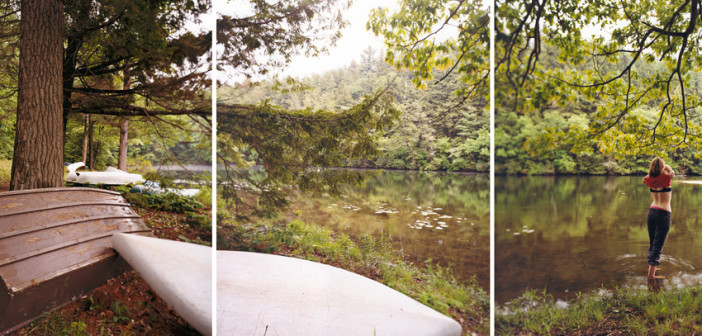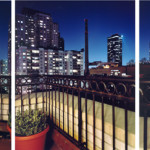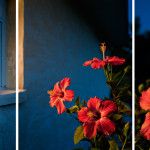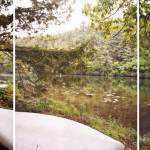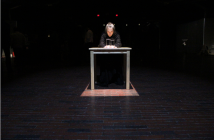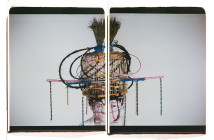David Hilliard is a Boston-based photographer known for his unique multi-panel images that present complex, yet personal narratives. Represented by galleries in Los Angeles, New York, Atlanta, and at the Bernard Toale Gallery here in Boston, David has become a major figure in photography, and an active photography educator. He has taught at Harvard, Mass Art, the School of the Museum of Fine Arts, and at Yale University. His monograph was published by Aperture this past spring.
David’s latest show, "Ladies" opened at the Bernard Toale Gallery on September 9th. We conducted our interview this past week.
BS: How did you come to work in multiple panels and with narrative in your imagery?
DH: The multiple panel structure grew out of my love of both film and photography....photos ability to stare and films ability to scan and move through space. I found that I could have the best of both worlds by creating this new structure. A kind of hybrid if you will. Regarding narrative...I don’t really know what to tell you. I’ve always loved stories and projecting possible stories onto something.
BS: How exciting that photography is multi-armed! Telling the story of ourselves, of what we see, and even what we imagine. What do you think is the relationship between autobiography and fiction in your work? Are they parallel elements or do they weave among each other?
DH: I’ve always loved fiction...but a fiction that’s based in a kind of truth, or a possible truth. I especially enjoy it within literature such as the writings of Raymond Carver, Russell Banks...even within the crazy humor of David Sedaris. In my own imagery I find myself reinventing reality to better suit my needs, tastes or memory of things...it’s all kind of selfish. And yes, it’s all woven together.
BS: Playing off the space between autobiography and fiction, is it important for the viewer to "believe" what they see? Or is the idea of "believing" a photo not necessary given the complexity of what photography has become?
DH: I think we’ve long since left "believing" a photo behind. Those days are over. I guess I’m more interested in giving the viewer an experience...making them think, question and perhaps sometimes believe.
BS: How important is it for your viewer to work? This "work" can mean the visual work of following elements of a multi panel narrative, of having to physically move around a piece due to the impossibility of focusing on the entire piece at once, or even having to consider the layered themes within a single piece or as a series.
DH: I like that you call it "work". Yes, I wouldn’t mind the viewer to work a bit; make associations between panels and moments in time. But I’m also content with someone having a completely easy experience with one of my photos. Perhaps tomorrow they’ll look at it again and start to see something else. I don’t want to be a dictator.
BS: Do you find that the pressures or expectations from others about your work have changed as your career has progressed?
DH: There has always been pressure. From college to grad school to the gallery scene there’s always someone telling you what to do...on some level or another. Not to mention the sick amount of pressure I put onto myself. Expectations are kind of the same thing...I try not to disappoint.
BS: You were born and raised near Boston, attended art school at Mass Art and have continued to live, teach, and exhibit in the city. What do you consider to be among the benefits of having this ongoing relationship with the city of Boston, artistically and otherwise?
DH: Well, I was born in Lowell and spent much of my youth there and in Tyngsborough. I have deep connections to those places. My family continues to be a big part of my life and work. Boston represents a place where I "found myself"...I know that’s such a trite term. But I did make my best and deepest friendships here. I met my partner here. It’s also the place where I really fell for photography. Boston is the city that first embraced me as an artist and started to take my work seriously....especially Bernie Toale. His gallery has really stuck by me and allowed me to grow.
BS: Your latest show, "Ladies," opened this month at the Bernard Toale Gallery. Why the focus on images of women?
DH: My photographs, although "man heavy" have always represented women. But I felt it would be interesting to put together a small exhibition where I take an exclusive look at some of the women in my life. I started with my friends, my mother, her friends, my friends kids etc.. It’s a work in progress. I think that as a gay man I’ve always gravitated toward women as friends and soul mates. There’s a sort of psychological complexity that exists in their world that I’ve always been a bit intimidated by and perhaps jealous of. In these images the women, their landscape and many of the objects within the photos, I hope, start to speak to some of these complexities.
- David Hilliard, Looker, C-print, 2005.
- David Hilliard, Window, C-print, 2005.
- David Hilliard, Beach Closed, C-print, 2004.
----
Links:
Bernard Toale Gallery
"Ladies" is on view September 7th- October 15th at the Bernard Toale Gallery.

